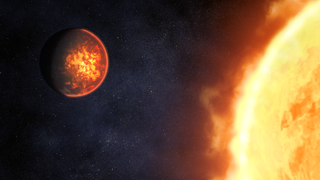James Webb Space Telescope will study two strange ‘super-Earths’
![]()
James Webb Space Telescope will study two strange ‘super-Earths’
By Elizabeth Howell published about 10 hours ago
Officials promise geology ‘from 50 light-years away.’

Artist’s impression of exoplanet 55 Cancri e. (Image credit: NASA, ESA, CSA, Dani Player (STScI))
The James Webb Space Telescope plans to explore strange, new rocky worlds in unprecedented detail.
The telescope’s scientific consortium has an ambitious agenda to study geology on these small planets from “50 light-years away”, they said in a statement Thursday (May 26). The work will be a big stretch for the new observatory, which should exit commissioning in a few weeks.
Rocky planets are more difficult to sight than gas giants in current telescope technology, due to the smaller planets’ relative brightness next to a star, and their relatively tiny size. But Webb’s powerful mirror and deep-space location should allow it to examine two planets slightly larger than Earth, known as “super-Earths.”
Should You Max Out 401(k) Contributions?NerdWallet
Neither of these worlds is habitable as we know it, but investigating them could still be a proving ground for future in-depth studies of planets like our own. The two planets Webb officials highlighted include the super-hot, lava-covered 55 Cancri e, and LHS 3844 b, which lacks a substantial atmosphere.
RECOMMENDED VIDEOS FOR YOU…
Click here for more Space.com videos…
CLOSE
1 second of 6 secondsVolume 0%
PLAY SOUND
Live updates: NASA’s James Webb Space Telescope mission Related: How the James Webb Space Telescope works in pictures

55 Cancri e orbits its parent star at a tight 1.5 million miles (2.4 million km), about four percent of the relative distance between Mercury and the sun.
Circling its star only once every 18 hours, the planet has blast furnace surface temperatures above the melting point of most types of rocks. Scientists also assumed the planet is tidally locked to the star, meaning one side always faces the scorching sun, although observations from NASA’s Spitzer Space Telescope suggest the hottest zone might be slightly offset.
Scientists say the offset heat might be due to a thick atmosphere that can move heat around the planet, or because it rains lava at night in a process that removes heat from the atmosphere. (The nighttime lava also suggests a day-night cycle, which might be due to a 3:2 resonance, or three rotations for every two orbits, that we see on Mercury in our own solar system.)
Two teams will test these hypotheses: one led by research scientist Renyu Hu of NASA’s Jet Propulsion Laboratory will examine the planet’s thermal emission for signs of an atmosphere, while a second team led by Alexis Brandeker, an associate professor from Stockholm University, will measure heat emittance from the lit side of 55 Cancri e.
RELATED STORIES:




















